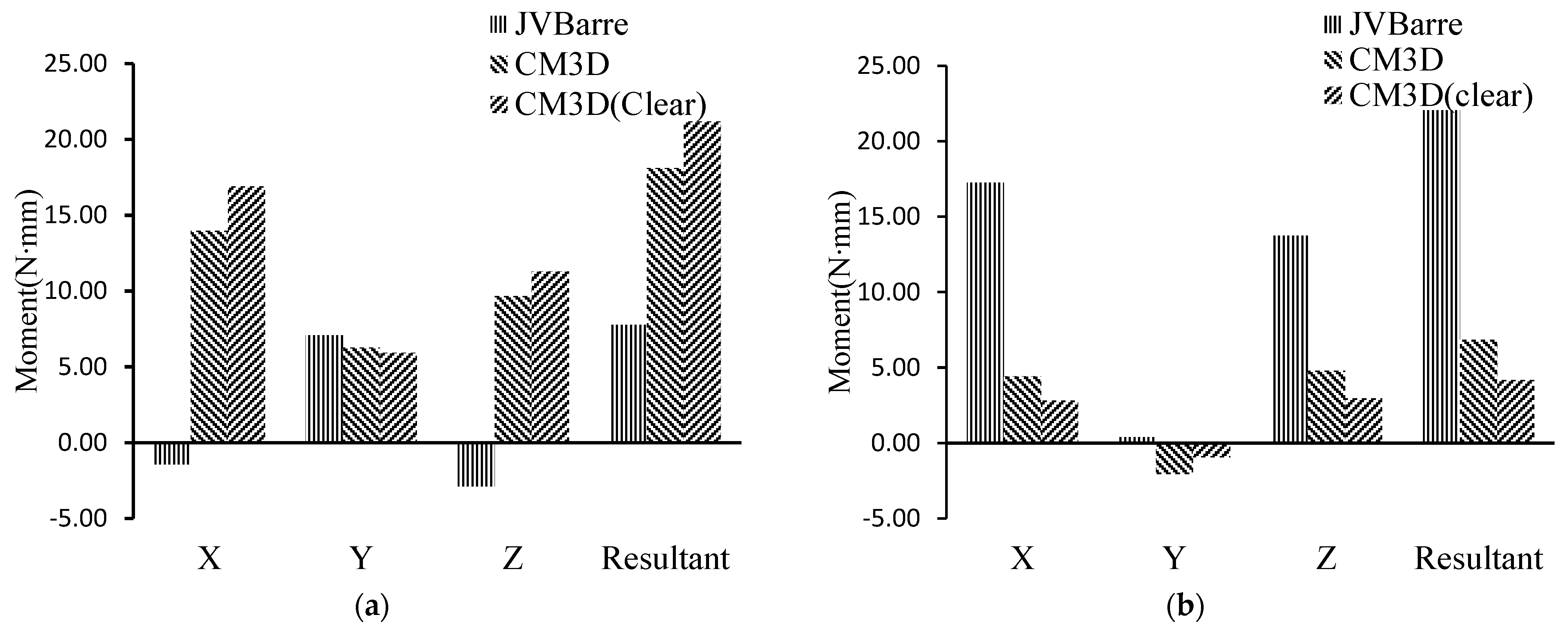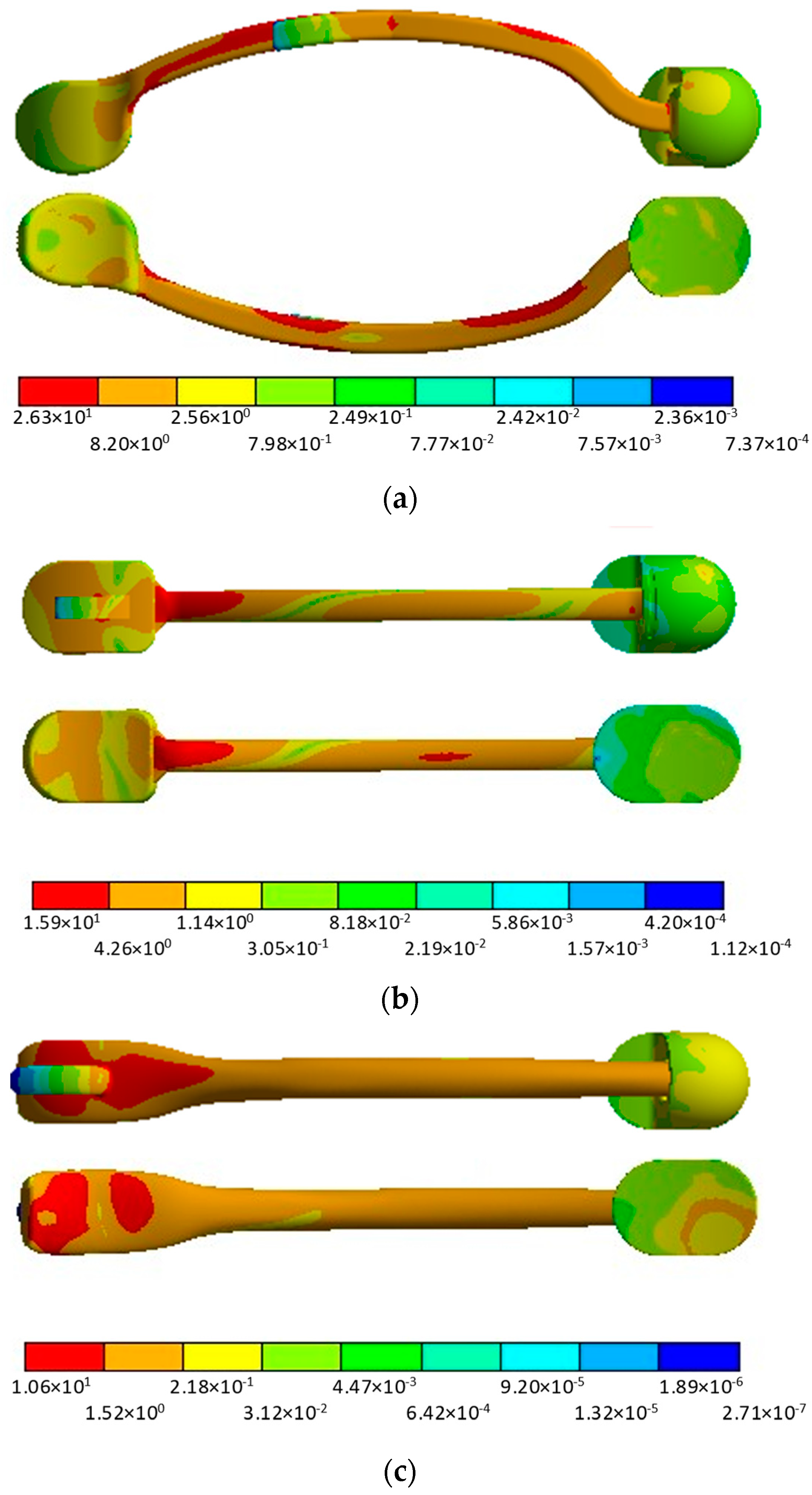Three-Dimensional Force Characterizations in Maxillary Molar Distalization: A Finite Element Study
Abstract
1. Introduction
2. Materials and Methods
3. Results
4. Discussion
5. Conclusions
Author Contributions
Funding
Institutional Review Board Statement
Informed Consent Statement
Data Availability Statement
Conflicts of Interest
Correction Statement
References
- Prabhakar, R.R. Prevalence of Malocclusion and Need for Early Orthodontic Treatment in Children. JCDR 2014, 8, ZC60–ZC61. [Google Scholar] [CrossRef] [PubMed]
- Bilgic, F.; Gelgor, I.E.; Celebi, A.A. Malocclusion Prevalence and Orthodontic Treatment Need in Central Anatolian Adolescents Compared to Euro-pean and Other Nations’ Adolescents. Dent. Press J. Orthod. 2015, 20, 75–81. [Google Scholar] [CrossRef] [PubMed]
- Papadopoulos, M.A. (Ed.) Orthodontic Treatment of the Class II Noncompliant Patient: Current Principles and Techniques; Mosby: Edinburgh, Scotland; New York, NY, USA, 2006; ISBN 978-0-7234-3391-0. [Google Scholar]
- Papadopoulos, M.A. Orthodontic Treatment of Class II Malocclusion with Miniscrew Implants. Am. J. Orthod. Dentofac. Orthop. 2008, 134, 604.e1–604.e16. [Google Scholar] [CrossRef] [PubMed]
- Class II Elastics and Skeletal Anchorage. Available online: https://www.jco-online.com/archive/2018/04/227-case-report-combining-skeletal-anchorage-and-intermaxillary-elastics-in-class-ii-treatment/ (accessed on 3 April 2023).
- Al-Anezi, S.A. Class II Malocclusion Treatment Using Combined Twin Block and Fixed Orthodontic Appliances—A Case Report. Saudi Dent. J. 2011, 23, 43–51. [Google Scholar] [CrossRef]
- Francisconi, M.F.; Henriques, J.F.C.; Janson, G.; de Freitas, K.M.S.; dos Santos, P.B.D. Stability of Class II Treatment with the Bionator Followed by Fixed Appliances. J. Appl. Oral Sci. 2013, 21, 547–553. [Google Scholar] [CrossRef]
- Arvind, P.; Jain, R.K. Skeletally Anchored Forsus Fatigue Resistant Device for Correction of Class II Malocclusions—A Systematic Review and Meta-Analysis. Orthod. Craniofacial Res. 2021, 24, 52–61. [Google Scholar] [CrossRef]
- Thukral, R.; Gupta, A. Invisalign: Invisible Orthodontic Treatment—A Review. J. Adv. Med. Dent. Sci. Res. 2015, 3, S42. [Google Scholar]
- Weir, T. Clear Aligners in Orthodontic Treatment. Aust. Dent. J. 2017, 62, 58–62. [Google Scholar] [CrossRef]
- Ke, Y.; Zhu, Y.; Zhu, M. A Comparison of Treatment Effectiveness between Clear Aligner and Fixed Appliance Therapies. BMC Oral Health 2019, 19, 24. [Google Scholar] [CrossRef]
- Verma, P.; George, A.M. Efficacy of Clear Aligners in Producing Molar Distalization: Systematic Review. APOS Trends Orthod. 2022, 11, 317–324. [Google Scholar] [CrossRef]
- Lombardo, L.; Cremonini, F.; Oliverio, T.; Cervinara, F.; Siciliani, G. Class II Correction with Carriere Motion 3D Appliance and Clear Aligner Therapy. J. Clin. Orthod. 2022, 56, 187–193. [Google Scholar]
- Gou, Y.; Ungvijanpunya, N.; Chen, L.; Zeng, Y.; Ye, H.; Cao, L. Clear Aligner vs Fixed Self-Ligating Appliances: Orthodontic Emergency during the 2020 Coronavirus Disease 2019 Pandemic. Am. J. Orthod. Dentofac. Orthop. 2022, 161, e400–e406. [Google Scholar] [CrossRef] [PubMed]
- Kim-Berman, H.; McNamara, J.A.; Lints, J.P.; McMullen, C.; Franchi, L. Treatment effects of the Carriere® Motion 3D™ Appliance for the Correction of Class II Malocclusion in Adolescents. Angle Orthod. 2019, 89, 839–846. [Google Scholar] [CrossRef] [PubMed]
- Montasser, M.A.; Scribante, A. Root Injury During Interradicular Insertion is the most Common Complication Associated with Orthodontic Miniscrews. J. Evid. -Based Dent. Pr. 2022, 22, 101688. [Google Scholar] [CrossRef] [PubMed]
- Xin, Y.; Wu, Y.; Chen, C.; Wang, C.; Zhao, L. Miniscrews for Orthodontic Anchorage: Analysis of Risk Factors Correlated with the Progressive Susceptibility to Failure. Am. J. Orthod. Dentofac. Orthop. 2022, 162, e192–e202. [Google Scholar] [CrossRef] [PubMed]
- Ramírez-Ossa, D.M.; Escobar-Correa, N.; Ramírez-Bustamante, M.A.; Agudelo-Suárez, A.A. An Umbrella Review of the Effectiveness of Temporary Anchorage Devices and the Factors That Contribute to Their Success or Failure. J. Evid. -Based Dent. Pr. 2020, 20, 101402. [Google Scholar] [CrossRef] [PubMed]
- Voudouris, D.J.C.; Voudouris, J.D. New JVBarre Maxillary Segmental Distaliser and BiTurbo2 System for Greater Aesthetics, Effective and Efficient Skeletal Class II Treatment: Control of Canine Over-Extrusion and Bodily Maxillary Molar Distalisation. Ortho Int. Mag. Orthod. 2019, 4, 14–19. [Google Scholar]
- Voudouris, J.C.; Voudouris, J.D.; Nicolay, O.; Glaser, B.; Nicozisis, J.; Theodoridis, G.; Carrillo, R.; Moshiri, M.; Masoud, M. Clear Aligners, Dentofacial Orthopedics, Physics and Supercorrection Prescription Biomechanics. A Meeting of the Minds. Semin. Orthod. 2022, 27, 202–258. [Google Scholar] [CrossRef]
- Nihara, J.; Gielo-Perczak, K.; Cardinal, L.; Saito, I.; Nanda, R.; Uribe, F. Finite element analysis of mandibular molar protraction mechanics using miniscrews. Eur. J. Orthod. 2014, 37, 95–100. [Google Scholar] [CrossRef]
- Çifter, M.; Saraç, M. Maxillary Posterior Intrusion Mechanics with Mini-Implant Anchorage Evaluated with the Finite Element Method. Am. J. Orthod. Dentofac. Orthop. 2011, 140, e233–e241. [Google Scholar] [CrossRef]
- Fiorillo, L.; Cicciù, M.; D’amico, C.; Mauceri, R.; Oteri, G.; Cervino, G. Finite Element Method and Von Mises Investigation on Bone Response to Dynamic Stress with a Novel Conical Dental Implant Connection. BioMed Res. Int. 2020, 2020, 2976067. [Google Scholar] [CrossRef] [PubMed]
- Fiorillo, L.; Milone, D.; D’andrea, D.; Santonocito, D.; Risitano, G.; Cervino, G.; Cicciù, M. Finite Element Analysis of Zirconia Dental Implant. Prosthesis 2022, 4, 490–499. [Google Scholar] [CrossRef]
- Cicciu, M.; Bramanti, E.; Matacena, G.; Guglielmino, E.; Risitano, G. FEM Evaluation of Cemented-Retained Versus Screw-Retained Dental Implant Single-Tooth Crown Prosthesis. Int. J. Clin. Exp. Med. 2014, 7, 817–825. [Google Scholar] [PubMed]
- Tominaga, J.-Y.; Ozaki, H.; Chiang, P.-C.; Sumi, M.; Tanaka, M.; Koga, Y.; Bourauel, C.; Yoshida, N. Effect of Bracket Slot and Archwire Dimensions on Anterior Tooth Movement During Space Closure in Sliding Mechanics: A 3-Dimensional Finite Element Study. Am. J. Orthod. Dentofac. Orthop. 2014, 146, 166–174. [Google Scholar] [CrossRef] [PubMed]
- Jayade, V.; Annigeri, S.; Jayade, C.; Thawani, P. Biomechanics of Torque from Twisted Rectangular Archwires: A Finite Element Investigation. Angle Orthod. 2007, 77, 214–220. [Google Scholar] [CrossRef] [PubMed]
- Chang, Y.-I.; Shin, S.-J.; Baek, S.-H. Three-Dimensional Finite Element Analysis in Distal En Masse Movement of the Maxillary Dentition with the Multiloop Edgewise Archwire. Eur. J. Orthod. 2004, 26, 339–345. [Google Scholar] [CrossRef]
- Jiang, T.; Wu, R.Y.; Wang, J.K.; Wang, H.H.; Tang, G.H. Clear Aligners for Maxillary Anterior En Masse Retraction: A 3D Finite Element Study. Sci. Rep. 2020, 10, 10156. [Google Scholar] [CrossRef]
- Rossini, G.; Schiaffino, M.; Parrini, S.; Sedran, A.; Deregibus, A.; Castroflorio, T. Upper Second Molar Distalization with Clear Aligners: A Finite Element Study. Appl. Sci. 2020, 10, 7739. [Google Scholar] [CrossRef]
- Park, J.-C.; Shin, H.-S.; Cha, J.-Y.; Park, J.-T. A three-Dimensional Finite Element Analysis of the Relationship between Masticatory Performance and Skeletal Malocclusion. J. Periodontal Implant Sci. 2015, 45, 8–13. [Google Scholar] [CrossRef]
- Xie, Q.; Li, D. The Cross-Sectional Effects of Ribbon Arch Wires on Class II Malocclusion Intermaxillary Traction: A Three-Dimensional Finite Element Analysis. BMC Oral Health 2021, 21, 501. [Google Scholar] [CrossRef]
- Kawamura, J.; Park, J.H.; Kojima, Y.; Kook, Y.; Kyung, H.; Chae, J. Biomechanical Analysis for Total Mesialization of the Mandibular Dentition: A Finite Element Study. Orthod. Craniofac. Res. 2019, 22, 329–336. [Google Scholar] [CrossRef] [PubMed]
- Chaudhry, A.; Sidhu, M.S.; Chaudhary, G.; Grover, S.; Chaudhry, N.; Kaushik, A. Evaluation of Stress Changes in the Mandible with a Fixed Functional Appliance: A Finite Element Study. Am. J. Orthod. Dentofac. Orthop. 2015, 147, 226–234. [Google Scholar] [CrossRef] [PubMed]
- Al Hamdany, A.K.; Hasan, L.A.; Alrawi, M.N.A.; Alhajar, E.H.K. PowerScope 2 Functional Appliance: A 3D Finite Element Simulation of Its Action on the Mandible. J. Oral Biol. Craniofac. Res. 2023, 13, 299–305. [Google Scholar] [CrossRef]
- Zhu, C.; Li, R.; Yuan, L.; Zheng, Y.; Jin, Y.; Li, H.; Liu, C.; Xia, L.; Fang, B. Effects of the Advanced Mandibular Spring on Mandibular Retrognathia Treatment: A Three-Dimensional Finite Element Study. BMC Oral Health 2022, 22, 271. [Google Scholar] [CrossRef] [PubMed]
- Wang, Q.; Dai, D.; Wang, J.; Chen, Y.; Zhang, C. Biomechanical Analysis of Effective Mandibular en-Masse Retraction Using Class II Elastics with a Clear Aligner: A Finite Element Study. Prog. Orthod. 2022, 23, 23. [Google Scholar] [CrossRef] [PubMed]
- Areepong, D.; Kim, K.B.; Oliver, D.R.; Ueno, H. The Class II Carriere Motion Appliance. Angle Orthod. 2020, 90, 491–499. [Google Scholar] [CrossRef]
- Fedorov, A.; Beichel, R.; Kalpathy-Cramer, J.; Finet, J.; Fillion-Robin, J.-C.; Pujol, S.; Bauer, C.; Jennings, D.; Fennessy, F.; Sonka, M.; et al. 3D Slicer as an image computing platform for the Quantitative Imaging Network. Magn. Reson. Imaging 2012, 30, 1323–1341. [Google Scholar] [CrossRef]
- SpecialChem Young’s Modulus: Modulus of Elasticity Units & Formula. Available online: https://omnexus.specialchem.com/polymer-properties/properties/young-modulus (accessed on 15 January 2023).
- Kojima, Y.; Fukui, H. A Finite Element Simulation of Initial Movement, Orthodontic Movement, and the Centre of Resistance of the Maxillary Teeth Connected with an Archwire. Eur. J. Orthod. 2014, 36, 255–261. [Google Scholar] [CrossRef]
- Ghafari, J.G.; Macari, A.T.; Haddad, R.V. Deep Bite: Treatment Options and Challenges. Semin. Orthod. 2013, 19, 253–266. [Google Scholar] [CrossRef]
- Feng, Y.; Kong, W.-D.; Cen, W.-J.; Zhou, X.-Z.; Zhang, W.; Li, Q.-T.; Guo, H.-Y.; Yu, J.-W. Finite Element Analysis of the Effect of Power arm Locations on Tooth Movement in Extraction Space Closure with Miniscrew Anchorage in Customized Lingual Orthodontic Treatment. Am. J. Orthod. Dentofac. Orthop. 2019, 156, 210–219. [Google Scholar] [CrossRef]
- Likitmongkolsakul, U.; Smithmaitrie, P.; Samruajbenjakun, B.; Aksornmuang, J. Development and Validation of 3D Finite Element Models for Prediction of Orthodontic Tooth Movement. Int. J. Dent. 2018, 2018, 4927503. [Google Scholar] [CrossRef] [PubMed]
- Chen, J.; Li, W.; Swain, M.V.; Darendeliler, M.A.; Li, Q. A Periodontal Ligament Driven Remodeling Algorithm for Orthodontic Tooth Movement. J. Biomech. 2014, 47, 1689–1695. [Google Scholar] [CrossRef] [PubMed]





| Young’s Modulus (GPa) | Poisson’s Ratio | |
|---|---|---|
| Tooth | 19.6 | 0.3 |
| JVB and CM3D | 200 | 0.3 |
| CM3D Clear | 3 | 0.33 |
| α | β | γ | |
|---|---|---|---|
| JVB | 85.0° | 50.2° | 139.8° |
| CM3D | 81.0° | 26.5° | 114.7° |
| CM3D Clear | 81.0° | 26.5° | 114.7° |
Disclaimer/Publisher’s Note: The statements, opinions and data contained in all publications are solely those of the individual author(s) and contributor(s) and not of MDPI and/or the editor(s). MDPI and/or the editor(s) disclaim responsibility for any injury to people or property resulting from any ideas, methods, instructions or products referred to in the content. |
© 2023 by the authors. Licensee MDPI, Basel, Switzerland. This article is an open access article distributed under the terms and conditions of the Creative Commons Attribution (CC BY) license (https://creativecommons.org/licenses/by/4.0/).
Share and Cite
Wang, J.; Tsolaki, A.; Voudouris, J.C.; Premaraj, T.S.; Premaraj, S.; Gu, L.; Dong, P. Three-Dimensional Force Characterizations in Maxillary Molar Distalization: A Finite Element Study. Appl. Sci. 2023, 13, 7195. https://doi.org/10.3390/app13127195
Wang J, Tsolaki A, Voudouris JC, Premaraj TS, Premaraj S, Gu L, Dong P. Three-Dimensional Force Characterizations in Maxillary Molar Distalization: A Finite Element Study. Applied Sciences. 2023; 13(12):7195. https://doi.org/10.3390/app13127195
Chicago/Turabian StyleWang, Jianing, Anastasia Tsolaki, John C. Voudouris, Thyagaseely Sheela Premaraj, Sundaralingam Premaraj, Linxia Gu, and Pengfei Dong. 2023. "Three-Dimensional Force Characterizations in Maxillary Molar Distalization: A Finite Element Study" Applied Sciences 13, no. 12: 7195. https://doi.org/10.3390/app13127195
APA StyleWang, J., Tsolaki, A., Voudouris, J. C., Premaraj, T. S., Premaraj, S., Gu, L., & Dong, P. (2023). Three-Dimensional Force Characterizations in Maxillary Molar Distalization: A Finite Element Study. Applied Sciences, 13(12), 7195. https://doi.org/10.3390/app13127195








